Marine Scrubber Systems Market - 2031
The global marine scrubber market size was valued at $4.9 billion in 2021, and is projected to reach $20.3 billion by 2031, growing at a CAGR of 16.2% from 2022 to 2031.
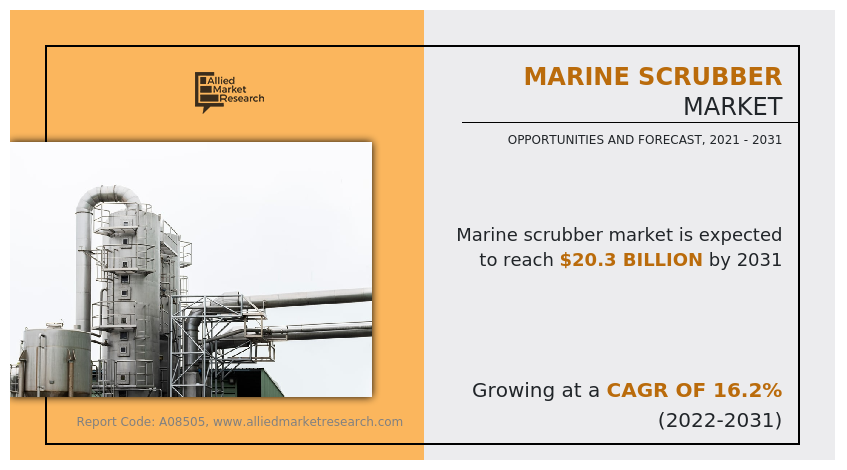
The marine scrubber market is segmented into Technology, Application and Installation.
Marine scrubbers, or exhaust gas cleaning systems, are used to remove particulate matter and hazardous components, such as sulfur oxides (SOx) and nitrogen oxides (NOx), from the exhaust gases created as a result of combustion processes in marine engines to perform pollution control. The alkaline scrubbing material in the scrubber is pushed through exhaust gas streams to neutralize the gases’ acidic nature and remove any particle debris from the exhaust. The used cleaning agent is subsequently collected with wash water, which can either be put in storage or disposed of right away as effluent.
The mechanism discharges the cleansed exhaust into the atmosphere. Marine scrubbers employ lime or caustic soda to de-sulfate the water, which results in sulfate-based salts that can be easily discarded because they don't harm the environment. Due to their alkaline nature, scrubbers may use sea water, fresh water with additional calcium or sodium sorbents, or pellets of hydrated lime as the scrubbing medium.
Marine scrubbers can be installed in different parts of the ship's exhaust system, such as the funnel, the main engine, or the auxiliary engines. They use a variety of methods to clean the exhaust gases, including the use of chemicals or water sprays, which react with the pollutants to form harmless substances or particles that can be safely released into the air or the sea. The use of marine scrubbers has become increasingly popular in recent years as an alternative to the use of low sulfur fuel to comply with environmental regulations such as the International Maritime Organization's (IMO) sulfur cap, which mandates a maximum sulfur content of 0.5% in marine fuel.
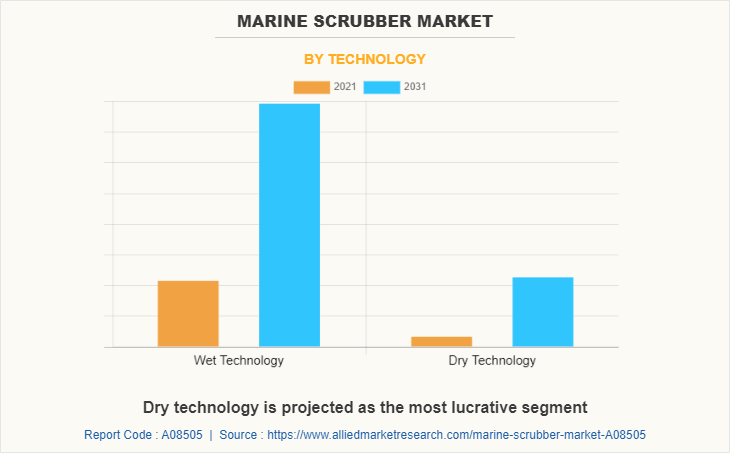
Air pollution has been a critical issue globally for decades, and various measures have been taken to control it. One of the most effective ways to reduce air pollution is through the use of wet technology in marine scrubber. Wet scrubbers are devices that are used to remove pollutants from exhaust gases. The global demand for wet technology has been growing at a significant pace due to the increased demand for clean air, stringent environmental regulations, and the need to reduce harmful emissions.
The marine industry is a significant market for marine scrubbers with wet technology. The International Maritime Organization (IMO) has set strict regulations for the reduction of sulfur oxide (SOx) emissions from ships. According to the regulation, ships must use fuel that contains no more than 0.5% sulfur content or install scrubbers to reduce their SOx emissions.
Wet technology is also being used in cruise ships to comply with the regulations and reduce their environmental impact. Cruise ships are often criticized for their high emissions of SOx, particulate matter, and other pollutants. As a result, many cruise lines are investing in scrubber technology to reduce their emissions and improve their environmental performance. Such demand is expected to increase the sales for wet technology in marine scrubber.
Factors such as implementation of sulfur 2020 rule, air pollution prevention policies & laws imposed by governments to protect environment, rise in international marine freight transport, and increase in demand for cargo transportation through ships are the major drivers for marine scrubber market. Moreover, factors such as strict regulatory policies for disposal of contaminated effluents from scrubber system and high installation & maintenance cost of marine scrubber restrain the growth of market. Furthermore, factors such as rise in e-commerce & online trade and growing demand for retrofit application as ship owner race against time to obey with rules and regulations are expected to create lucrative opportunities for leading players of marine scrubber market.
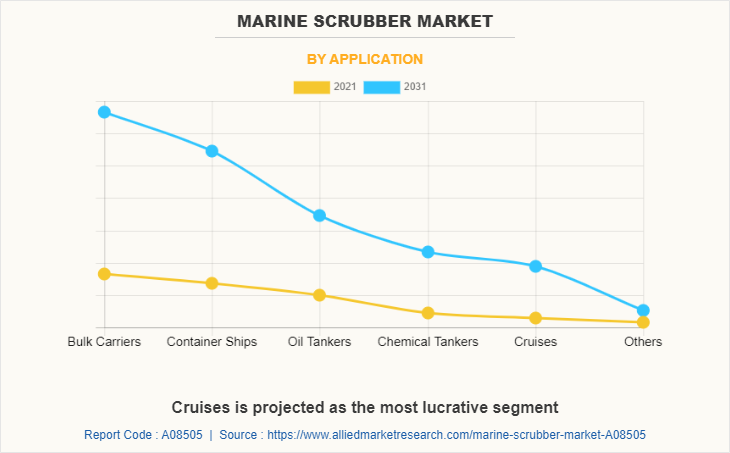
The marine scrubber market is segmented on the basis of technology type, application, installation, and region. On the basis of technology type, it is divided into wet technology, and dry technology. On the basis of application, it is classified into bulk carriers, container ships, oil tankers, chemical tankers, cruises, and others. On the basis of Installation, it is classified into new build, and retrofit. On the basis of region, the market is analyzed across North America, Europe, Asia-Pacific, and LAMEA.
Growth drivers, restraints, and opportunities are explained in the study to better understand the market dynamics. This study further highlights key areas of investment. In addition, it includes Porter’s five forces analysis to understand the competitive scenario of the industry and the role of each stakeholder. The study features strategies adopted by key market players to maintain their foothold in the market.
The leading players operating in the marine scrubber market are Alfa Laval AB, Andritz AG, Fuji Electric Co., Ltd., GEA Group AG, Kwang Sung Co Ltd., Mitsubishi Heavy Industries Ltd., Pacific Green Marine Technologies, Valmet Oyj, Wärtsilä Oyj Abp, and Yara International ASA.
Implementation of sulfur 2020 rule
According to IMO (International Maritime Organization) MARPOL convention to inhibit pollution from ships, the content of sulfur in the fuel used by marines needs to decrease from 3.5% to 0.5% from January 2020. This rule was in response to the rise in health-related and environmental worries increased by environmental organizations and several governments across the globe. In observance of this rule, marine operators need to install scrubber or exhaust cleaning systems on ships to clean the discharges before they are released out into the environment. They also need to use LNG-based fuel or need to shift from HSFO (high-sulfur fuel oil) to VLSFO (very low-sulfur fuel oil). This rule has urged the marine manufacturers to adopt battery-driven electric or hybrid propulsion.
According to the report published by Drewry (UK) in 2018, the cost of installing a marine scrubber varies from $ 2 million to $ 6 million. Extremely big marines can use up to 60-70 metric tons of fuel in one day. The differentiation in price in moving to VLSFO from HSFO is nearly $ 238.5 higher per metric ton. As of 2021, more than 5% of all vessels have been installed with scrubbers and are set for operation. The battery-operated propulsion engines could save ship owners from utilizing high priced fuel and installing scrubbers. Moreover, the electric type of propulsion systems mounted on ships have a huge market potential as they reduce consumption of fuel along with the complete cost of operations. Depending on the size of ships and vessels, the number of operators and electrification can decrease the annual fuel costs by 10%-80-% in a Tully electric setup and 3% to 5% in a hybrid setup. On average, maintenance costs can be lowered by up to 50% with an electric propulsion system. Such policies across the world drive the global marine scrubber market share.
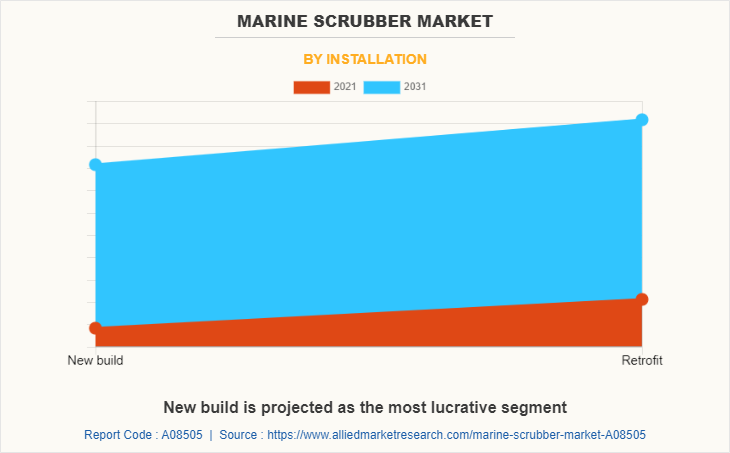
Rising international marine freight transport
Maritime transport is essential to trade internationally. The main mode of transport for global trade is shipping through ocean, and as per UNCTAD, about 80% of the volume of international trade in goods is done through ocean, and the percentage is rising for most of the emerging countries. This source of transport is more feasible and cheaper for international trade than air, rail, and road transport. The global maritime is likely to further grow at a moderate annual rate from 2022 to 2031. The development of the global shipment fleet has showed similar trends. The trading through marine had bobbed back in 2021 owing to the opening of pent-up demand, as well as building and restocking inventory. The quick boost in demand in 2021 after the dismal situation in 2020 due to the pandemic had caused into deficiencies of shipping capacity. This has forced many shipowners to procure newbuild or retrofit their old ships with marine scrubber to bridge this demand-supply gap.
A rise in demand has been witnessed for the transportation of cargo through water ways. This is due to the fact that the cargos are efficiently transferred to the other end in a securer way as compared to other means of transportation. Moreover, cargo ships are less expensive for shipping goods as compared to road and air transits. Ships can carry more cargo from one place to another within a short span of time. As per the records of UNCTAD, approximately 1,687 million tons of cargo is transported every year in around 177.6 million containers covering 998 billion tons-miles. The recent developments in commercial vessels and giant players’ innovation of better and efficient cargo ships equipped with latest technology such as advanced sensors, navigation system and other components have created demand for cargo transportation through ships. This leads to the growth of the marine scrubber market.The Asia-Pacific region has become a global manufacturing hub in recent times due to its wealth of manpower and raw materials manufacturers & suppliers. Thus, the sale for container ship is considerably high in this region owing to the growth in export of raw and manufactured goods. The year 2021 saw increased demand for oil due to the reopening of economies, expansion of Asian economies, and growth in OPEC production. This growth is still ongoing and may boost the demand for big crude carriers. Such huge sales of ships across the world especially in Asia-Pacific is expected to increase the sales of marine scrubbers.
High installation and maintenance cost of marine scrubber
The production process and costing of marine scrubber differs on the basis of their size and total amount of pollutant to be removed. The technology used in producing such scrubber is one of the most crucial parts of the value chain. The production is dominated by several marine scrubber manufacturers, as it is a vulnerable market. The installation of a marine scrubber can be expensive, and it requires significant modifications to the ship's existing exhaust system. Moreover, marine scrubbers require energy to operate, which can increase a ship's overall energy consumption and carbon footprint.
The amount of energy required can vary depending on the type of scrubber and the amount of pollutant being removed. The cost of installation can be a significant barrier to adoption of marine scrubber for some shipowners. The marine scrubbers require regular cleaning and maintenance to ensure they continue to operate effectively. This can be time-consuming and may require specialized knowledge or expertise.
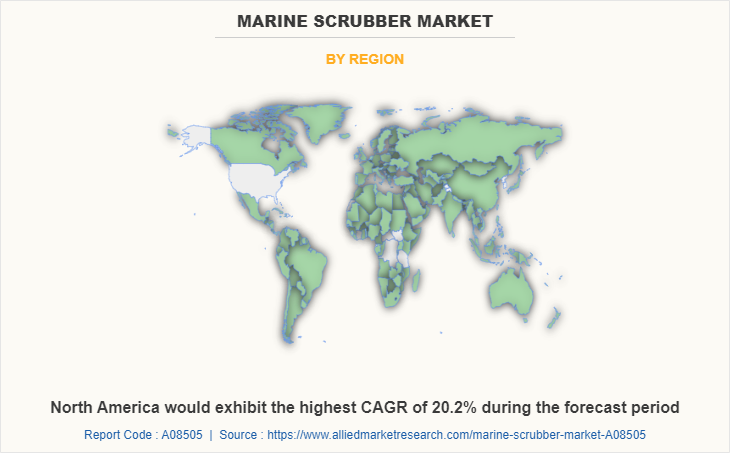
Rise of e-commerce and online trade
The pandemic saw a change in the way customers purchased any good. The pandemic speeded up the shift from physical stores to digital shopping in roughly two years. Consumers wanted a safe way to tailor their requirements, which led to a sudden spike in online retail industry. According to Hellenic Ships, the total sales of new ships was 1,286 in 2021, which has increased port operations and trading activities across the world, which has also impacted the sales of marine scrubber across the world.
The whole industry suffered shortages of shipping containers, capacity, and other equipment, indirectly affecting the marine ships and marine scrubber market. However, reduced supply chain uncertainties and logistical bottlenecks are important for suppliers and retailers to keep more stock in hand. As a result, the e-commerce provided new business opportunities to sea trading, including warehousing, shipping, and distribution facilities at seaports. The transport through marine, especially at global level, is cheaper and more feasible as compared to road, rail, air, and transport. This trend of growth in online trade and e-commerce has enhanced the sales of marine ships. The rise in online trade and e-commerce activities, therefore, is likely to boost sea trade and the demand for vessels, which, in turn, is anticipated to create an opportunity for the growth of the marine scrubber market.
Key Benefits For Stakeholders
- This report provides a quantitative analysis of the market segments, current trends, estimations, and dynamics of the marine scrubber market analysis from 2021 to 2031 to identify the prevailing marine scrubber market opportunities.
- The market research is offered along with information related to key drivers, restraints, and opportunities.
- Porter's five forces analysis highlights the potency of buyers and suppliers to enable stakeholders make profit-oriented business decisions and strengthen their supplier-buyer network.
- In-depth analysis of the marine scrubber market segmentation assists to determine the prevailing market opportunities.
- Major countries in each region are mapped according to their revenue contribution to the global market.
- Market player positioning facilitates benchmarking and provides a clear understanding of the present position of the market players.
- The report includes the analysis of the regional as well as global marine scrubber market trends, key players, market segments, application areas, and market growth strategies.
Marine Scrubber Market Report Highlights
| Aspects | Details |
| Market Size By 2031 | USD 20.3 billion |
| Growth Rate | CAGR of 16.2% |
| Forecast period | 2021 - 2031 |
| Report Pages | 411 |
| By Technology |
|
| By Application |
|
| By Installation |
|
| By Region |
|
| Key Market Players | Wartsila, Valmet, Fuji Electric Co., Ltd., Yara International ASA, Pacific Green Group, ANDRITZ, KwangSung, Alfa Laval, GEA Group Aktiengesellschaft, Mitsubishi Heavy Industries, Ltd. |
Analyst Review
This section provides the opinions of various top-level CXOs in the global marine scrubber market. As concerns about air pollution and climate change grow, regulations regarding emissions from ships have become increasingly strict. One area of focus has been the exhaust gas emissions from ships, which can be a significant source of pollutants such as sulfur oxides (SOx), nitrogen oxides (NOx), and particulate matter. The market has seen significant growth in recent years due to the implementation of international emission regulations, such as the International Maritime Organization's (IMO) sulfur cap, which limits the sulfur content of fuel used by ships.
The demand for marine scrubbers has increased as ship owners and operators seek to comply with these regulations and reduce their environmental impact. The marine scrubber market is expected to continue to grow in the coming years, driven by rise in environmental regulations and a growth in awareness of the impact of air pollution on human health & the environment. The shipping industry is responsible for a significant portion of global greenhouse gas emissions, with estimates indicating that it is responsible for approximately 2-3% of total global emissions. As concerns about climate change and air pollution have grown, regulations regarding emissions from ships have become increasingly strict. One area of focus has been the exhaust gas emissions from ships, which can be a significant source of pollutants such as sulfur oxides (SOx), nitrogen oxides (NOx), and particulate matter. In response, the demand for marine scrubber has increased drastically in recent years, with a variety of technologies and solutions being developed to help reduce emissions from ships.
The demand for hybrid scrubber systems is expected to increase in the coming years as they provide more flexibility than other types of scrubbers. Hybrid systems are able to operate in both closed-loop and open-loop modes, and they allow ships to switch between the two depending on their operational needs. Additionally, hybrid scrubbers use either seawater or freshwater as the alkaline reactant, making them more versatile and allowing for more efficient operation. As environmental regulations become strict and the demand for cleaner air increases, hybrid scrubber systems are likely to become more popular in the marine industry.
The market is likely to see new entrants, as smaller companies develop innovative solutions to meet the needs of the market. The future of the marine scrubber looks positive, as more countries and regions look forward to implementing regulations regarding emissions from ships. However, there are also concerns about the environmental impact of discharging pollutants into the ocean, which could lead to increased demand for closed-loop scrubbers. In addition, advances in technology could lead to new and more efficient types of marine scrubber, further driving growth of the market.
Rise of e-commerce & online trade and growing demand for retrofit application are the upcoming trends of marine scrubber market in the world.
Bulk carriers, container ships, oil tankers, chemical tankers, cruises, and others are the leading application of marine scrubber market.
Asia-Pacific is the largest regional market for marine scrubber.
The estimated industry size of marine scrubber is $20,311.2 million by 2031.
Wet technology is the leading segment by technology in terms of sales of marine scrubber.
Loading Table Of Content...



